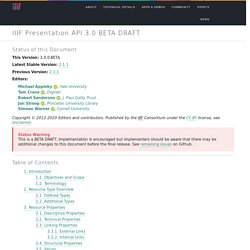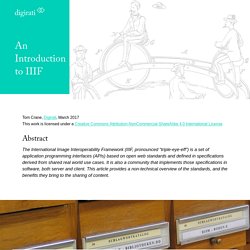

Cataloging Ethics Steering Committee Website. Members of the Cataloging Ethics Steering Committee: Beth Shoemaker, Emory University (co-chair) (ALA ALCTS CaMMS representative) Staffing/Work Conditions Working Group Liaison Karen Snow, School of Information Studies, Dominican University (co-chair) (ALA ALCTS CaMMS representative) Classification Working Group Liaison May Chan, University of Toronto (CFLA-FCAB CMSC representative) Access Scope & Infrastructure Working Group Liaison Jane Daniels, Cardiff Metropolitan University (CILIP CIG representative) Authority Work Working Group Liaison Sarah Furger, Joliet Public Library Subject Headings Working Group Liaison Diane Pennington, Department of Computer and Information Sciences, University of Strathclyde (CILIP CIG representative) Resource Discovery & Accessibility Working Group Liaison.

La preservación audiovisual en la era de los píxeles (Free ebook) International Image Interoperability Framework. Status of this Document This Version: 3.0.0-BETA Latest Stable Version: 2.1.1 Previous Version: 2.1.1 Editors: Copyright © 2012-2020 Editors and contributors.

Status Warning This is a BETA DRAFT. Table of Contents 1. Access to digital representations of objects is a fundamental requirement for many research activities, for the transmission of cultural knowledge, and for the daily pursuits of every web citizen. Collections of both digitized physical objects and much born-digital content benefit from a standardized description of their structure, layout, and presentation mode. VRA Core Schemas and Documentation : VRA CORE - a data standard for the description of works of visual culture: Official Web Site. VRA Core4 Intro. An Introduction to IIIF. How does the Presentation API work?

Manifests for things The Presentation API describes “just enough metadata to drive a remote viewing experience”. This metadata is a IIIF Manifest. The Manifest represents the thing. A book. A manifest is what a IIIF viewer loads to display the object. If the object the manifest represents is a photograph, there might only be one conceptually distinct view of it that we wish to convey via the Presentation API, to end up on a user's screen. Canvases for views These views are represented by Canvases. The canvas is the abstract space; we provide an image to paint the canvas The Canvas keeps the content separate from the conceptual model of the page of the book, or the painting, or the movie.
This means that you can provide more than one representation of a view. You may have a manuscript represented as a sequence of Canvases, but for some of those Canvases you have no image at all - the page was known to exist, but is now lost. Annotations for content. Cataloging Cultural Objects (CCO) Livro tratamento de arquivos de ciencia e tecnologia organizacao e acesso. International Image Interoperability Framework. Community Snapshot IIIF-Discuss = 772 members IIIF Slack = 573 members IIIF images online = 350+ million IIIF Consortium = 47 founding institutions.

Welcome to OCLC, our latest institutional member. The IIIF Consortium (IIIF-C) continues to welcome founding members through December 2017 (please email admin@iiif.io or see the IIIF-C FAQ for more information). Announcements and Actions Farewell and Thank You As of November 17, Sheila Rabun will be stepping away from her position as the IIIF Community and Communications Officer. Save the Date - 2018 IIIF Conference The 2018 IIIF Conference will be held in Washington, DC, May 21-25, 2018, co-hosted by the Library of Congress, the Smithsonian Institution, and the Folger Shakespeare Library. IIIF Consulting: American Art Collaborative JPEG2000 & OpenJPEG Survey The first phase of work to improve OpenJPEG, an open source JPEG2000 codec, has drawn to a close, resulting in the latest release of OpenJPEG, version 2.3.0. International Image Interoperability Framework. The Lost Picture Show: Hollywood Archivists Can’t Outpace Obsolescence.
When the renowned cinematographer Emmanuel Lubezki began planning to shoot the wilderness drama The Revenant, he decided that to capture the stark, frozen beauty of a Canadian winter, he would use no artificial light, instead relying on sunlight, moonlight, and fire.

He also planned to use traditional film cameras for most of the shooting, reserving digital cameras for low-light scenes. He quickly realized, though, that film “didn’t have the sensitivity to capture the scenes we were trying to shoot, especially the things we shot at dawn and dusk,” as he told an interviewer. The digital footage, by contrast, had no noise or graininess, and the equipment held up much better in the extreme cold. The crew soon switched over to digital cameras exclusively. “I felt this was my divorce from film—finally,” Lubezki said. Lubezki’s late-breaking discovery of digital is one that other filmmakers the world over have been making since the first digital cameras came to market in the late 1990s. VRA Core Schemas and Documentation : VRA CORE - a data standard for the description of works of visual culture: Official Web Site (Library of Congress)
A Guide to the Description of Architectural Drawings (Getty Research Institute)